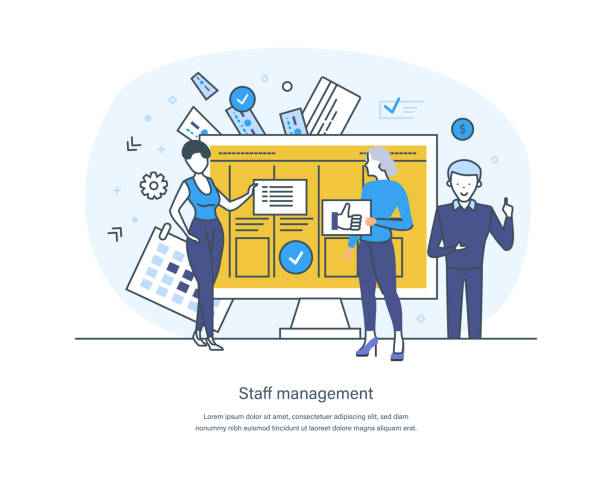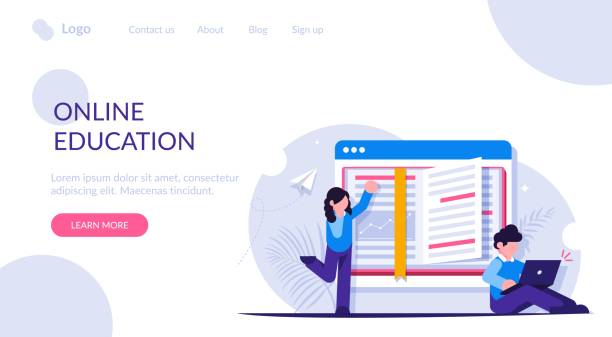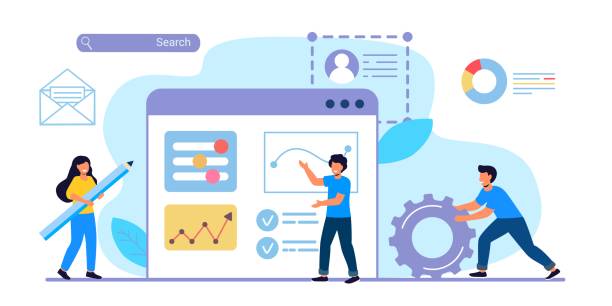Introduction to the Importance of Secure Website Design in Today’s World

In the current digital age, the existence of a secure website is no longer a luxury option, but an undeniable necessity.
#CyberSecurity, #DataProtection, and #UserTrust are considered the main pillars of success for any online business.
With the increasing rise of cyberattacks and the complexity of infiltration methods, secure website design and resistance against these threats has become a strategic priority.
This not only protects sensitive user information but also safeguards your brand’s credibility and reputation.
Did you know that a security breach can lead to the loss of millions of dollars, heavy fines, and even the bankruptcy of a company?
Understanding the basic concepts of web security is vital for every developer and online business owner.
These concepts include identifying common vulnerabilities, implementing strong security protocols, and adopting proactive approaches.
The goal of secure website design is to create an online environment where users can confidently share their information and use website services.
This is a continuous process that requires regular updates, constant monitoring, and rapid response to new threats.
Without sufficient attention to these aspects, any online platform will be at serious risk.
Therefore, investing in web security solutions is an investment in the future and sustainability of your business.
Are you losing business opportunities because of an outdated website? With Rasawab, solve the problem of not attracting potential customers through your website forever!
✅ Attract more high-quality leads
✅ Increase brand credibility in the eyes of customers
⚡ Get free consultation for corporate website design
Identifying and Countering the Most Common Web Vulnerabilities

In the vast and complex world of the web, awareness of common vulnerabilities is the first step towards secure website design.
Cyber attackers are constantly searching for weaknesses in web code, server configurations, and databases to gain access to information or disrupt the website.
One of the most well-known attacks is SQL Injection, where an attacker, by injecting malicious SQL code into website inputs, can access the database and read, modify, or delete information.
This attack is particularly dangerous for websites that do not properly validate user inputs.
Cross-Site Scripting (XSS) is also another frequently used threat where an attacker injects malicious script code into web pages, and these codes are executed in the victim’s browser.
This can lead to the theft of cookies, user session information, and even modification of page content.
Cross-Site Request Forgery (CSRF) attacks also allow attackers to send malicious requests to a website on behalf of authenticated users, without the user being aware of it.
In addition, vulnerabilities related to weak authentication, improper session management, insecure server configuration, and sensitive information disclosure are among the important challenges that secure website design teams must carefully address.
Countering these vulnerabilities requires specialized knowledge, the use of secure frameworks, and continuous updating of security knowledge.
Principles of Secure Coding and Best Practices

Secure coding is not just a skill, but a philosophy in the process of secure website design.
This approach means considering security aspects at every stage of the software development lifecycle, from initial design to deployment and maintenance.
The most crucial step in secure coding is thorough and comprehensive validation of all user inputs.
Any data entering the system from external sources, whether form information, URL parameters, or API requests, must be rigorously checked and sanitized to prevent the injection of malicious code.
Using Prepared Statements and parameterizing queries in database interactions is the best defense against SQL Injection.
Furthermore, proper error and exception management is also very important.
Disclosing sensitive information in error messages can give attackers clues about the system’s internal structure.
Therefore, error messages should be general and devoid of technical details.
Using strong hash functions for storing passwords instead of plain text storage, and implementing Access Control List (ACL) mechanisms to ensure each user only has access to resources they are authorized for, are other key principles.
Also, using reputable and up-to-date security frameworks and libraries can significantly relieve the security burden on developers and facilitate the process of creating attack-resistant websites.
Below is a comparative table of secure and insecure coding practices:
| Secure Practice | Insecure Practice |
|---|---|
| Strict user input validation | No validation or weak input validation |
| Using Prepared Statements for SQL queries | Dynamically building SQL queries with string concatenation |
| Hashing passwords with strong functions (Bcrypt, Argon2) | Storing passwords in plain text or with weak hashing |
| Careful session management | Lack of session expiration control or weak session management |
| Implementing CSRF Tokens mechanisms | Not using CSRF Tokens |
| Setting HTTP security headers (CSP, X-XSS-Protection) | Not setting appropriate security headers |
Database Security: The Beating Heart of Your Website

The database, as the main repository of information, is one of the most sensitive parts of any online platform.
Protecting this information against unauthorized access, unwanted changes, or deletion is a fundamental pillar of secure website design.
One of the fundamental methods for data security is encrypting sensitive information.
This means that even if an attacker successfully gains access to the database, the encrypted information will be unusable for them.
Using disk-level encryption or column-level encryption, depending on data sensitivity, are effective solutions.
In addition to encryption, meticulous implementation of access control mechanisms is also vital.
Every user, whether a developer or an application, should only have access to the minimum amount of information and permissions required to perform their tasks (Principle of Least Privilege).
Never use a “root” or “admin” user account with full access for day-to-day website operations.
Furthermore, continuous monitoring of database activities and meticulous logging of all operations can help quickly identify suspicious patterns and potential attacks.
Regular and secure backup of the database and storing them in separate, secure locations is also of paramount importance, as it enables data recovery in the event of a successful attack or system failure.
Without database security, all your efforts for secure website design will be fruitless.
Is your company’s website as professional and trustworthy as it should be? With specialized corporate website design by Rasawab, create an online presence that reflects your credibility and attracts more customers.
✅ Build a powerful and professional image for your brand
✅ Convert visitors into real customers
⚡ Get a free consultation now!
User Authentication and Access Management

Strong authentication and meticulous access management are the front line of defense in secure website design.
These two processes ensure that only authorized users gain access to the system and can only perform tasks defined for them.
Implementing strong password policies and enforcing the use of complex passwords (including uppercase and lowercase letters, numbers, and special characters) and their periodic change is the first step in this direction.
Furthermore, the use of Two-Factor Authentication (2FA) or Multi-Factor Authentication (MFA) is highly recommended.
These methods, by adding another layer of security, prevent attackers from gaining access even if the password is compromised.
Session Management is also a crucial aspect.
User sessions must have an expiration time and automatically expire after a period of inactivity.
Also, session tokens should be random, unpredictable, encrypted, and transmitted via HTTPS to prevent session hijacking.
In access management, Role-Based Access Control (RBAC) models are the best practice.
In this model, access is granted based on predefined roles for users (e.g., administrator, editor, regular user), which reduces management complexities and enhances security.
Correct implementation of these mechanisms is an integral part of securing online platforms and secure website design.
Securing Servers and Infrastructure for Online Platforms

Website security is not limited to secure coding alone; the server and network infrastructure hosting the website must be equally secure.
The “Server Hardening” process includes a set of measures to reduce the Attack Surface of the server.
These measures include removing unnecessary software, closing unused ports, proper firewall configuration, and applying least privileges for users and system services.
Using up-to-date operating systems and regularly applying Security Patches for all software installed on the server, including web servers (like Apache or Nginx), databases, and programming languages, is crucial.
Proper network configuration is also an important part of secure website design.
This includes using powerful firewalls, Intrusion Detection Systems (IDS), and Intrusion Prevention Systems (IPS) to monitor network traffic and block suspicious activities.
Furthermore, ensuring that website servers are located in a separate and isolated network (DMZ) and access to them is restricted can prevent direct attacks on database servers or other sensitive parts of the infrastructure.
Proper SSH key management, encrypting all administrative communications, and continuous monitoring of system logs to identify any anomalies are other fundamental practices in securing online infrastructures.
These measures ensure that even with relatively secure code, the underlying infrastructure also has sufficient resistance against attacks.
Penetration Testing and Periodic Security Audits

Secure website design is not a static process; rather, it requires continuous review and improvement.
Even with adherence to best coding practices and secure configurations, unintended weaknesses may exist in the system that are only discovered through specialized tests.
Penetration Testing and periodic security audits are vital tools for evaluating a website’s resistance to real attacks.
In penetration testing, security experts (often known as “ethical hackers”) use techniques and tools similar to real attackers to attempt to infiltrate the system and discover vulnerabilities.
These tests can be black-box (without knowledge of the internal structure) or white-box (with access to source code and system structure).
Security audits involve examining code, server configuration, security policies, and operational processes to identify weaknesses.
These audits should be conducted regularly and periodically, especially after any major system change or addition of new features.
Automated Vulnerability Scanners can help with initial problem identification but are never a substitute for manual penetration testing and in-depth evaluation by experts.
Reports from these tests and audits provide a roadmap for the development team to address weaknesses and continuously enhance the website’s security level.
This proactive and aggressive approach to security assessment is considered a vital principle in maintaining website security and secure website design.
Below are the key stages of a comprehensive security audit:
| Stage | Description |
|---|---|
| Planning and Information Gathering | Defining scope, objectives, methodology, and gathering initial information about the system. |
| Vulnerability Scanning and Analysis | Using automated and manual tools to identify vulnerabilities and weaknesses. |
| Penetration Testing and Exploitation | Attempting to exploit discovered vulnerabilities to gain unauthorized access. |
| Post-Exploitation | Assessing the level of access gained and evaluating potential damage. |
| Reporting | Detailed documentation of all vulnerabilities, exploitation methods, and corrective recommendations. |
| Review and Remediation | Implementing recommendations and re-testing to ensure vulnerabilities are resolved. |
The Role of SSL/TLS Certificates and HTTPS Protocol

In any discussion about secure website design, the importance of SSL/TLS certificates and the HTTPS protocol cannot be overlooked.
These technologies are the backbone of secure communications on the web.
SSL (Secure Sockets Layer) and its successor TLS (Transport Layer Security) are protocols responsible for encrypting data transmitted between the user’s browser and the website’s server.
When a website uses HTTPS (Hypertext Transfer Protocol Secure), it means its communications are encrypted via SSL/TLS.
This provides three fundamental benefits: Confidentiality, Integrity, and Authentication.
Confidentiality means that data exchanged between the user and the server will be unintelligible and unreadable to any third party who might intercept it.
Integrity ensures that data has not been tampered with during transmission and is exactly what the sender sent.
Authentication assures the user that they are communicating with the genuine website and not a fake one created by attackers.
This prevents “Man-in-the-Middle” attacks.
SSL/TLS certificates also play a crucial role in SEO; search engines like Google prioritize websites that use HTTPS in their rankings.
Therefore, for any website seeking to gain user trust and succeed in the online space, the complete and correct implementation of HTTPS is an integral part of secure website design.
Is your company’s website as professional and trustworthy as it should be? With specialized corporate website design by Rasawab, create an online presence that reflects your credibility and attracts more customers.
✅ Build a powerful and professional image for your brand
✅ Convert visitors into real customers
⚡ Get a free consultation now!
Incident Response and Data Recovery Plan

Even the most advanced secure website design cannot be 100% impenetrable.
In the world of cybersecurity, the assumption is that “sooner or later, you will be attacked.” For this reason, having an Incident Response Plan and a Disaster Recovery Plan is a critical component of any organization’s cybersecurity strategy.
These plans help teams react quickly and effectively in the event of a security breach or system failure, minimize damage, and resume operations in the shortest possible time.
An incident response plan should include specific stages: identification (detecting the intrusion), containment (preventing further damage), eradication and cleanup (removing the cause of the intrusion), recovery (restoring the system to operational status), and lessons learned (analyzing the incident to prevent its recurrence).
This plan should be regularly practiced and updated so that teams are familiar with it and can perform well in emergency situations.
Furthermore, regular and automated backups of all website data and configurations, and storing them in secure and separate locations (preferably off-site), are fundamental principles of data recovery.
This ensures that in the event of data loss due to cyberattack, hardware failure, or natural disasters, the website can be quickly restored to its previous state.
Neglecting this section can render all investments in secure website design ineffective.
The Future of Web Security and Emerging Trends

The field of cybersecurity is constantly evolving, and with the emergence of new technologies, new challenges and solutions arise.
Secure website design in the future will require understanding and adapting to these emerging trends.
Artificial Intelligence (AI) and Machine Learning (ML) will play an increasing role in detecting and preventing attacks, with the ability to analyze vast amounts of data and identify threat patterns that are impossible for humans.
These technologies can be used in intrusion detection systems, next-generation firewalls, and even user behavior analysis to detect suspicious activities.
Blockchain technology also holds great potential for improving security, especially in areas of decentralized authentication, identity management, and ensuring data integrity.
Given the distributed and immutable nature of blockchain, we can expect new security solutions based on it in the future.
The “Zero Trust” concept is also an approach where no user or device, whether inside or outside the network, is automatically trusted.
In this model, every access request must be fully authenticated and authorized.
This approach, especially with the expansion of remote work and network complexity, is becoming a standard in web security architecture.
Secure website design developers and specialists must constantly keep their knowledge up-to-date and be prepared to counter future threats to provide truly robust and secure websites.
Frequently Asked Questions
| Row | Question | Answer |
|---|---|---|
| 1 | What is secure website design? | The process of designing and developing websites that are resistant to cyberattacks and protect user data and privacy. |
| 2 | Why is website security important? | To prevent data breaches, financial losses, damage to company reputation, and maintain user trust. |
| 3 | What are some common website security threats? | SQL Injection, XSS (Cross-Site Scripting), CSRF (Cross-Site Request Forgery), weak authentication, and unpatched software. |
| 4 | What are SSL/TLS and what is their role? | Protocols for encrypting data between the user’s browser and the website’s server, ensuring secure and private communication. |
| 5 | How can SQL Injection attacks be prevented? | By using Prepared Statements/Parameterized Queries, input validation, and ORMs (Object-Relational Mappers). |
| 6 | What is the role of a Web Application Firewall (WAF) in security? | A WAF monitors and filters HTTP traffic between a web application and the Internet to prevent malicious attacks. |
| 7 | Why is regular updating of software and libraries essential? | Updates include patches for known security vulnerabilities that attackers can exploit. |
| 8 | How can XSS attacks be prevented? | By sanitizing and escaping all user inputs before displaying them on the web page and using Content Security Policy (CSP). |
| 9 | What does the Principle of Least Privilege mean? | It means that users and systems are granted only the minimum necessary permissions to perform their tasks to prevent unnecessary access to resources. |
| 10 | What is the importance of proper user session management? | To prevent user session hijacking and unauthorized access to user accounts through secure and expiring session tokens. |
And other services of Rasawab Advertising Agency in the field of advertising
Smart Conversion Rate Optimization: A professional solution for analyzing customer behavior with a focus on optimizing key pages.
Smart Data Analysis: An innovative service for improving SEO ranking through attractive UI design.
Smart Google Ads: A professional solution for user engagement focusing on optimizing key pages.
Smart Digital Advertising: Revolutionize click-through rates with Google Ads management.
Smart Customer Journey Map: An innovative platform for improving customer behavior analysis with SEO-driven content strategy.
And over hundreds of other services in the field of internet advertising, advertising consulting, and organizational solutions
Internet Advertising | Advertising Strategy | Advertorial
Sources
WordPress Site Security
Website Security Checklist
The Importance of SSL in Site Security
10 Tips for Increasing Site Security
? To elevate your business in the digital world, Rasawab Afarin is with you, offering innovative marketing solutions and fast and professional website design, to ensure a powerful and lasting presence.
📍 Tehran, Mirdamad Street, next to Central Bank, Kazeroon Janubi Alley, Ramin Alley, No. 6



